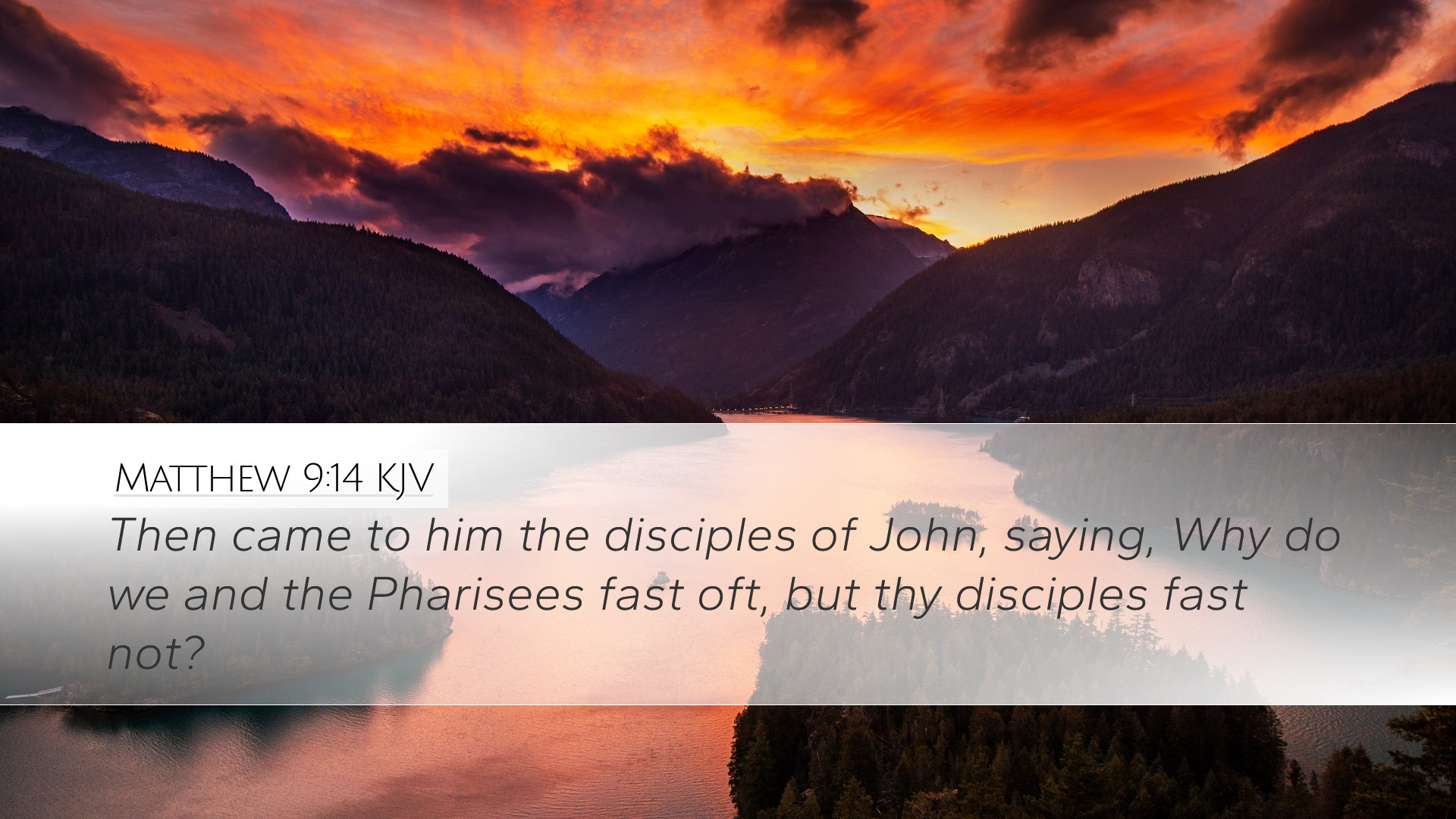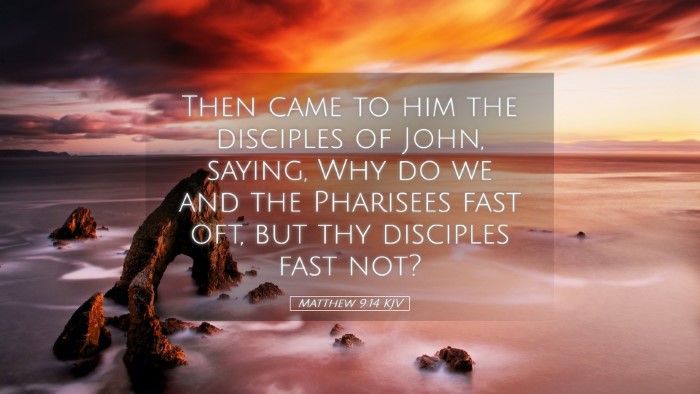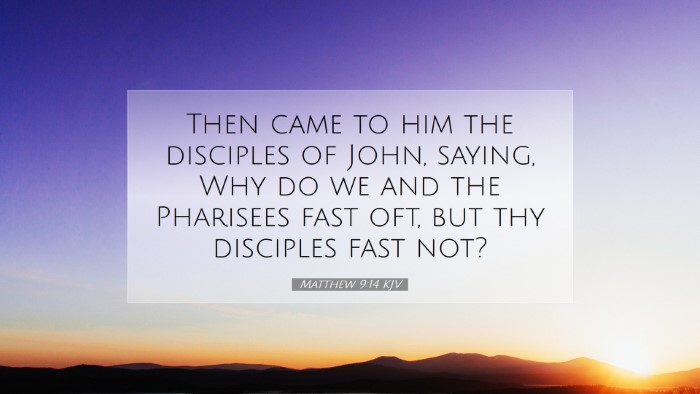Commentary on Matthew 9:14
Verse: "Then came to him the disciples of John, saying, Why do we and the Pharisees fast oft, but thy disciples fast not?"
Introduction
The inquiry presented in Matthew 9:14 arises from a juxtaposition of fasting practices among different religious groups. This passage offers profound insights into the nature of Christian fasting, the identity of Jesus as the Messiah, and the transformative essence of His ministry.
Contextual Background
Matthew 9:14 is situated within a broader narrative where Jesus has been performing miracles and claiming authority over sin and sickness. The contrast between Jesus’ ministry and the established Jewish practices is stark, particularly in the realm of fasting.
The disciples of John the Baptist approach Jesus directly, reflecting a moment of curiosity and perhaps confusion regarding the apparent absence of fasting within Jesus’ ministry. This speaks to the tension that existed between the new covenant initiated by Christ and the older Jewish traditions.
Insights from Matthew Henry
According to Matthew Henry, the question from John’s disciples reveals a misunderstanding of the purpose of fasting in the context of the Christian faith. Henry notes that fasting is a practice intended for seeking God, yet Jesus’ presence signified the fulfillment of what fasting anticipated. With Jesus, the object of their longing was present, and therefore, fasting as a common practice lost its urgency.
Henry emphasizes that the disciples of Jesus “were a company of joyful men, while the disciples of John were mourning.” This distinction highlights the celebratory dimension of Jesus’ ministry, where He, the Bridegroom, is present, and thus fasting in sorrow was out of place.
Contributions from Albert Barnes
Albert Barnes elaborates on the traditional practice of fasting among the Pharisees and the disciples of John. He points out that while they fast frequently, the disciples of Jesus did not partake in such rituals. Barnes interprets this as a deliberate choice reflecting the differing missions of John and Jesus. John’s role was one of preparation, calling for repentance and humility, while Jesus announced the kingdom of God and brought with Him an era of joy.
He asserts that in the presence of Christ, fasting should not be a mere ritual but instead transformed into a state of joy and celebration of the new life that Christ offers. The emphasis on joy is critical: the coming of Christ signifies the time for celebration, painting a picture of the transformative power of the new covenant established through His blood.
Reflections by Adam Clarke
Adam Clarke provides a theological analysis of the motivations behind the fasting of the Pharisees and John’s disciples compared to that of Jesus’ followers. He draws attention to the legalistic nature of the Pharisees’ fasting, which was often done to showcase piety rather than to genuinely seek God. Clarke suggests that such outward displays lacked any true spiritual substance and thus missed the essence of what fasting should entail.
Moreover, Clarke highlights that Jesus’ rebuttal of the question implies a deeper teaching about the character of God and His kingdom. He points to the metaphor of the bridegroom, suggesting that during the time of celebration, the proper response is not mourning but festivity. This shift signifies a major theological transition where the focus moves from ritualistic adherence to heartfelt relationship with God through Christ.
Theological Implications
Matthew 9:14 invites discussion on the nature of religious observance and the heart of true worship. As interpreted by the commentators, fasting is not intrinsically negative; rather, it is the heart and intention behind the act that matter most. The kingdom of God introduced by Jesus creates a new paradigm where joy is paramount.
- The Shift from Ritual to Relationship: Jesus’ response signifies that genuine relationship with God surpasses mere ritual. This is a call to move from a legalistic approach, embodied by the Pharisees, to a heartfelt engagement with God.
- The Celebration of Christ’s Presence: The imagery of the bridegroom emphasizes that in the presence of Jesus, the focus should shift to celebration and joy rather than solemnity, illustrating a fundamental aspect of the new covenant.
- The New Wine and New Wineskins: In the subsequent verses, Jesus speaks of new wine requiring new wineskins, symbolizing that the message of the kingdom and the nature of faith must adapt to embrace the radical changes He brings.
Practical Applications for Ministry
This verse and its accompanying analysis offer several practical applications for pastors and ministry leaders:
- Teaching on Fasting: Fasting can be redefined in light of the grace offered through Christ. It should not merely be about abstention but about what we are turning towards—an invitation to deeper communion with God.
- Celebrating Spiritual Realities: Churches should foster an environment that celebrates what God is doing in their midst, making room for joyful worship and expressions of faith.
- Holistic Approaches to Discipleship: Encourage discipleship that integrates joy, celebration, and the transformative nature of a life lived in relationship with Christ, focusing on heart transformation rather than mere behavioral modification.
Conclusion
Matthew 9:14 serves as a rich text for examining the nature of genuine spiritual practices and the implications of Jesus' presence. By understanding the insights of Matthew Henry, Albert Barnes, and Adam Clarke, we see the invitation to live a life marked not by old traditions of mourning but by the new wine of joy found in a relationship with Jesus Christ. For students, theologians, and pastors, it is a reminder to continually evaluate our practices of faith against the profound reality of who Jesus is and the joyous kingdom He has brought forth.


